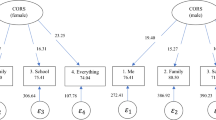Abstract
The need for assessing impairment in functioning as an integral part of child mental health services research is discussed. Methodologic difficulties related to problems in case definition, the conceptual definition of impairment and social adaptation, and the assessment of the construct across cultures are also addressed. In addition, a critical review of existing child impairment measures with published psychometric properties is presented. The measures are divided into three types: measures of global impairment, domain-specific measures, and symptom-specific measures. The paper concludes that the choice of the measure to use in health services research needs to be determined according to the main goals of the study, the population in which the instrument is going to be used, and the interviewer's knowledge of the child. Other characteristics of the measures of impairment that the researcher should consider are also discussed.
Similar content being viewed by others
REFERENCES
Achenbach, T. M. (1991). Manual for the Child Behavior Checklist/4–18 and 1991 Profile. Burlington, VT: University of Vermont Department of Psychiatry.
Achenbach, T. M., Bird, H. R., Canino, G., Phares, V., Gould, M. S., & Rubio-Stipec, M. (1990). Epidemiological comparisons of Puerto Rican and U.S. mainland children: Parent, teacher, and self reports. Journal of the American Academy of Child and Adolescent Psychiatry, 29, 84–93.
American Psychiatric Association. (1980). Diagnostic and Statistical Manual of Mental Disorders (DSM-III). Washington, DC: American Psychiatric Association
American Psychiatric Association. (1994). Diagnostic and Statistical Manual of Mental Disorders (DSM-IV). Washington, DC: American Psychiatric Association.
Anastasi, A. (1950). The concept of validity in the interpretation of test scores. Journal of Psychology and Educational Measures, 67–78.
Anastasi, A. (1986). Evolving concepts of test validation. Annals of Developmental Psychology, 37, 1–15.
Angold, A., Costello, E. J. (1995). A test re-test reliability study of child-reported psychiatric symptoms and diagnoses using the Child and Adolescent Psychiatric Assessment (CAPAC). Psychological Medicine, 25, 755–762.
Angold, A., Costello, E. J. (in press). The Child and Adolescent Psychiatric Assessment. Journal of the American Academy of Child and Adolescent Psychiatry.
Angold, A., Costello, E. J., Farmer, E. M. Z., Burns, B. J., & Erkanli, A. (1999). Impaired but undiagnosed. Journal of the American Academy of Child and Adolescent Psychiatry, 38, 129–137.
Angold, A., Prendergast, M., Cox, A., Harrington, R., Simonoff, E., & Rutter, M. (1995). The Child and Adolescent Psychiatric Assessment (CAPA). Psychological Medicine, 25, 739–753.
Beiser, M., Lancee, W., Gotowiec, A., Sack, W., & Redshirt, R. (1993). Measuring self-perceived role competence among first nations and non native children. Canadian Journal of Psychiatry, 38, 412–419.
Bickerton, W. L., Vostanis, P., Cumella, & Chung, M. C. (1995). Adaptive functioning and behaviour of children with special needs: comparison between ethnic groups. Mental Handicap Research, 8, 156–167.
Bickman, L., Guthrie, P., Foster, E., M., Lambert, E., W., Summerfelt, W. T., Breda, C., & Heflinger, C., A. (1995). Evaluating Managed Mental Health Services: The Fort Bragg Experiment. New York: Plenum.
Bickman, L., Lambert, E., W., Karver, M., & Andrade, A. R. (1998). Two low cost measures of child and adolescent functioning for services research. Evaluation and Program Planning, 21, 263–275.
Biederman, J., Newcon, J., & Sprich, S. (1991). Comorbidity of attention deficit hyperactivity disorder with conduct, depressive, anxiety and other disorders. American Journal of Psychiatry, 148, 564–577.
Bird, H. R., Andrews, H., Schwab-Stone, M., Goodman, S., Dulcan, M., Richters, J., Rubio-Stipec, M., Moore, R. E., Chiang, P. H., Hoven, C., Canino, G., Fisher, P., & Gould, M. S. (1996). Global measures of impairment for epidemiologic and clinical use with children and adolescents. International Journal of Methods in Psychiatric Research, 6, 295–307.
Bird, H., Canino, G., Rubio-Stipec, M., & Ribera, J. (1987). Further measures of the psychometric properties of the Children's Global Assessment Scale. Archives of General Psychiatry, 44, 821–825.
Bird, H., Canino, G., Rubio-Stipec, M., Gould, M. S., Ribera J., Sesman, M., Woodbury, M., Huertas-Goldman, S., Pagán, A., Sánchez-Lacay, A., & Moscoso, M. (1988). Estimates of the prevalence of childhood maladjustment in a community survey in Puerto Rico. Archives of General Psychiatry, 45, 1120–1126.
Bird, H., Davies, M., & Fisher, P. (in preparation). How specific is specific impairment?
Bird, H. R., Shaffer, D., Fisher, P., Gould, M. S., Staghezza, B., Chen, J. Y., & Hoven, C. (1993). The Columbia Impairment Scale (CIS): Pilot findings on a measure of global impairment for children and adolescents. International Journal of Methods and Psychiatric Research, 3, 167–176.
Bird, H. R., Yager, T. J., Staghezza, B., Gould, M. S., Canino, G., & Rubio-Stipec, M. (1990). Impairment in the epidemiological measurement of childhood psychopathology in the community. Journal of the American Academy of Child and Adolescent Psychiatry, 29, 796–803.
Burns, B. J., Costello, E. J., Angold, A., Tweed, D., Stangl, D., Farmer, E. M. Z., & Erkanli, A. (1995). Children's mental health service use across service sectors. Health Affairs, 14, 147–159.
Canino, G., & Canino, I. (1982). Family therapy: A culturally syntonic approach for Hispanics. Hospital Community Psychiatry, 33, 299–303.
Chronbach, L. J., & Meehl, P. E. (1955). Construct validity in psychological tests. Psychological Bulletin, 52, 281–302.
Cicchetti, D. V., Sparrow, S. S., & Carter, A. S. (1991). Development and validation of two Vineland adaptive behavior screening instruments. Paper presented at the annual American Psychological Association, San Francisco, CA.
Costello, E. J., Angold, A., Burns, B. J., Erkanli, A., Stangl, D. K., & Tweed, D. L. (1996). The Great Smoky Mountains Study of Youth: Functional impairment and severe emotional disturbance. Archives of General Psychiatry, 53, 1137–1143.
Costello, E. J., Messer, S. C., Bird, H. R., Cohen, P., & Reinherz, H. Z. (1999). Prevalence of Serious Emotional Disturbance: A reanalysis of community studies. Journal of Child and Family Studies, 7, 411–432.
Costello, E. J., Angold, A., Burns, B. J., Erkanli, A., Stangl, D. K., & Tweed, D. L. (1996). The great smoky mountain study of youth: Functional impairment and severe emotional disturbance. Archives of General Psychiatry, 53, 1137–1143.
Endicott, J., Spitzer, R. L., Fleiss, J. L., & Cohen, J. (1976). The Global Assessment Scale (GAS). Archives of General Psychiatry, 33, 766–771.
Epstein, M. H., & Sharma, J. (1977). Behavioral and Emotional Rating Scale (BERS): A strength-based approach to assessment. Austin: PRO-ED.
Federal Register. (1993, May 20) no. 58:29425, Substance Abuse and Mental Health Services Administration (notices).
Goodman, S. H., Hoven, C. W., Narrow, W. E., Cohen, P., Fielding, B., Alegria, M., Leaf, P. J., Kandel, D., Horowitz, S. M., Bravo, M., Moore, R., & Dulcan, M. K. (1998). Measurement of risk for mental disorders and competence in a psychiatric epidemiologic community survey: The NIMH methods for the epidemiology of child and adolescent mental disorders (MECA) study. International Journal of Methods in Psychiatric Research, 33, 162–173.
Gulliksen, H. (1950). Intrinsic validity. American Psychologist, 5, 511–517.
Harwood, R. L., Miller, J. G., & Irizarry, N. (1995). Culture and attachment: Perceptions of the child in context. New York: Guilford.
Hoagwood, K, Jensen, P., Petti, T., & Burns, B. (1996). Outcomes of mental health care for children and adolescents: I. A comprehensive conceptual model. Journal of the American Academy of Child and Adolescent Psychiatry, 35, 1055–1063.
Hodges, K., McKnew, D., Cytryn, L., Ster, L., & Kline, J. (1982). The Child Assessment Schedule (CAS) Diagnostic Interview: A report on reliability and validity. Journal of the American Academy of Child and Adolescent Psychiatry, 21, 468–473.
Hodges, K., & Wong, M. M. (1996). Psychometric characteristics of a multidimensional measure to assess impairment: The Child and Adolescent Functional Assessment Scale. Journal of Child and Family Studies, 4, 445–467.
Hodges, K., & Wong, M. M. (1997). Use of the Child and Adolescent Functional Assessment Scale to predict service utilization and cost. Journal of Mental Health Administration, 24, 278–290.
Jenkins, J. G. (1946). Validity for what? Journal of Consulting Psychology, 10, 93–98.
Jensen, P. D., & Hoagwood, K. (1997). The Book of Names: DSM-IV in Context? Development Psychopathology, 231–249.
John, K., Davis, G., Prusoff, B. A., & Warner, V. (1987). The Social Adjustment Inventory for Children and Adolescents (SAICA): Testing of a new semi-structured interview. Journal of the American Academy of Child and Adolescent Psychiatry, 26, 898–911.
Katsching, H. (1983). Methods for measuring social adjustment. In T. Helgason (Ed.), Methodology in evaluation of psychiatric treatment (pp 205–218). New York: Cambridge University Press.
Lahey, B. B., Flagg, E. W., Bird, H. R., Schwab-Stone, M., Canino, G., Dulcan, M. K., Leaf, P. J., Davies, M., Brogan, D., Bourdon, K., Horwitz, S. M., Rubio-Stipec, M., Freeman, D. H., Lichtman, J., Shaffer, D., Goodman, S. H., Narrow, W. E., Weissman, M. M., Kandel, D. B., Jensen, P. S., Richters, J. E., & Regier, D. A. (1996). The NIMH methods for the epidemiology of child and adolescent mental disorder (MECA) study: Background and methodology. Journal of the American Academy of Child and Adolescent Psychiatry, 35, 855–864.
Peak, H. (1953). Problems of Objective Observation. In L. Festinger & D. Katz (eds), Research methods in the behavioral sciences (pp 243–300). New York: Dryden.
Shaffer, D., Gould, M. S., Brasic, J., Ambrosini, P. J., Fisher, P. W., Bird, H. R., & Aluwahlia, S. (1983). A Children's Global Assessment Scale (C-GAS). Archives of General Psychiatry, 40, 1228–1231.
Shaffer, D., Fisher, P., Dulcan, M., Davis, D., Piacentini, J., Schwab-Stone, M., Lahey, B., Bourdon, K., Jensen, P., Bird, H., Canino, G., & Regier, D. (1996). The NIMH Diagnostic Interview Schedule for Children Version 2.3 (DISC 2.3): Description, acceptability, prevalences, and performance in the MECA study. Journal of the American Academy of Child and Adolescent Psychiatry, 35, 865–877.
Sparrow, S. S., Balla, D. A., & Cicchetti, D. V. (1984). Vineland adaptive behavior scales: Interview edition-survey form manual. Circle Pines, MN: American Guidance Service.
Spitzer, R, L., Fleiss, J. L., & Endicott, J. (1978). Problems of classification: Reliability and validity. In M. A. Lipton, A. DiMascio, & K. F. Killam (eds.) Psychopharmacology: A Generation of Progress. New York: Raven.
Wallace, S., R. (1965). Criteria for what? American Psychologist. 16, 228–231.
Williams, J. B. W. (1985a). The multiaxial system of DSM-III: Where did it come from and where should it go? I. Its origins and critiques. Archives General Psychiatry. 42, 75–180.
Williams, J. B. W. (1985b). The multiaxial system of DSM-III: Where did it come from and where should it go? II. Empirical studies, innovations, and recommendations. Archives General Psychiatry. 42, 181–186.
Wing, J. K., Bebbington, P., & Robins, L. N. (1981). What is a Case? London: Grant McIntyre, Ltd.
Author information
Authors and Affiliations
Rights and permissions
About this article
Cite this article
Canino, G., Costello, E.J. & Angold, A. Assessing Functional Impairment and Social Adaptation for Child Mental Health Services Research: A Review of Measures. Ment Health Serv Res 1, 93–108 (1999). https://doi.org/10.1023/A:1022334303731
Issue Date:
DOI: https://doi.org/10.1023/A:1022334303731




